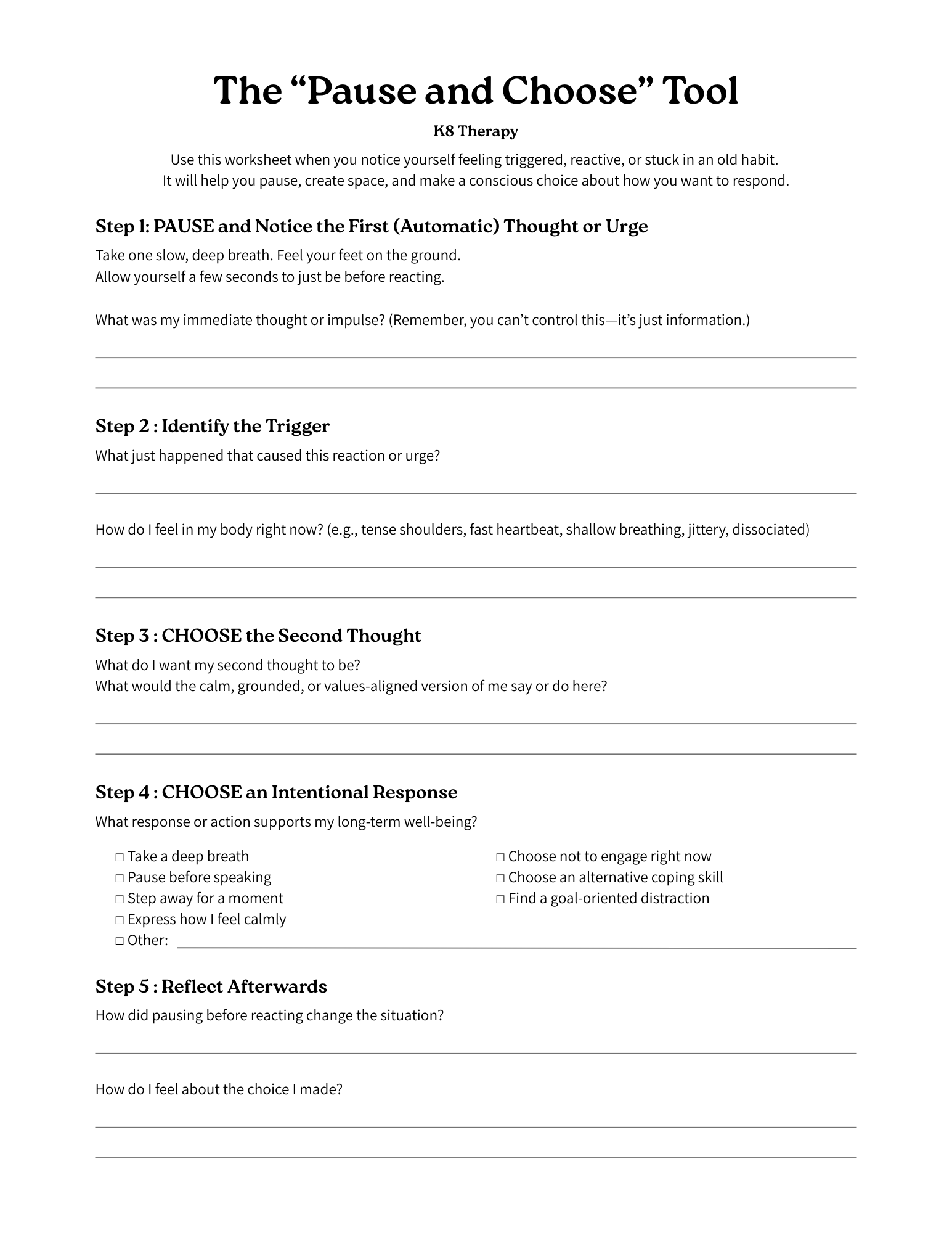Pause and Choose: How to Respond Instead of React
At K8 Therapy, one of the most powerful skills I teach my clients is how to pause before reacting. This tool helps people break out of automatic, unhelpful habits and move toward more intentional, values-aligned choices.
Whether it’s saying something in the heat of the moment, scrolling mindlessly when stressed, or falling into repetitive patterns of avoidance or self-criticism—many of our reactions happen without awareness. They’re often fast, automatic, and rooted in old wiring designed to protect us.
But here’s the truth: you can’t always control your first thought—but you can control your second.
That space between the first thought and the second thought is where your power lives.
Why the Pause Matters
The pause is what turns reactivity into choice. When you stop—even for a few seconds—you shift from the emotional brain to the thinking brain. You interrupt the automatic loop and create space to ask yourself, “What do I want my response to be?”
In that pause, you can choose differently. You can take a breath, notice what’s happening in your body, and reconnect with your values instead of your impulses.
How to Practice the Pause and Choose Tool
You can use this skill in nearly any situation where you feel reactive, impulsive, or stuck in habit. Here’s how:
Step 1: Pause
Catch yourself in the moment and stop. Take one deep breath. Feel your feet on the floor. Give yourself a few seconds of space before doing or saying anything.
Step 2: Notice the Trigger
Maybe someone said something that frustrates you, or you notice the urge to reach for your phone or food, or you feel an anxious thought rising.
Ask yourself:
What am I feeling right now?
What just triggered me?
What am I about to do automatically?
Step 3: Choose
This is where your second thought comes in. Ask:
What response aligns with who I want to be right now?
What choice supports my long-term goals rather than my short-term impulse?
How can I act in a way that feels grounded, not reactive?
Step 4: Act Intentionally
Identify the response or action that supports your long-term well-being. Re-direct yourself to engage with that intentional choice.
Step 5: Reflect
Afterward, take a moment to notice how it felt to respond differently. Even a small shift—like pausing for one breath before replying—builds self-awareness and self-control over time.
Why This Tool Works
When you pause, you train your brain to slow down the automatic chain between emotion and action. Over time, this builds emotional regulation, mindfulness, and resilience. It doesn’t mean you won’t ever feel triggered or have an unhelpful thought—but it means you don’t have to act on it.
The goal isn’t perfection—it’s awareness. Each time you pause, you’re strengthening the part of you that chooses consciously, and that’s where lasting change begins.
Putting It Into Practice
Try using Pause and Choose this week in one small area of your life:
Before reacting in a tough conversation
Before checking your phone out of habit
Before engaging in a coping behavior that no longer serves you
Each pause is a moment of empowerment—a reminder that while you can’t control your first thought, you always have a choice about your second.
Take the Next Step
Ready to start practicing the power of choice in your own life? Download our “Pause and Choose” worksheet to help you challenge automatic thoughts, manage emotional reactions, and make empowered decisions every day.
Or, book a session with Kate at K8 Therapy to learn personalized strategies, strengthen your voice, and create lasting freedom from unwanted emotional reactions or old habits that are no longer serving you. Your healing starts with one choice—today.
If you struggle with emotional eating, please read the The Power of Choice: How to Pause and Reframe Restrictive and Emotional Eating to learn how to use the “Pause and Choose” tool to build mindful eating skills.
